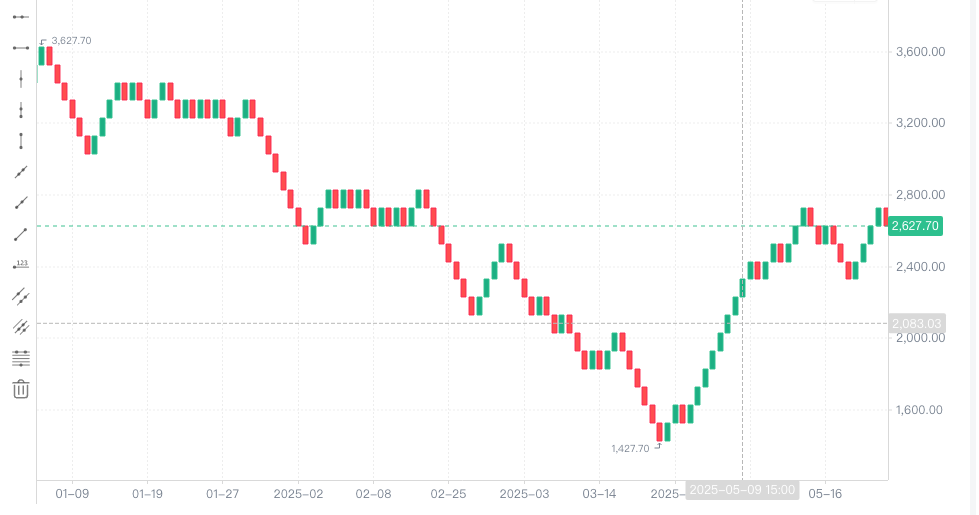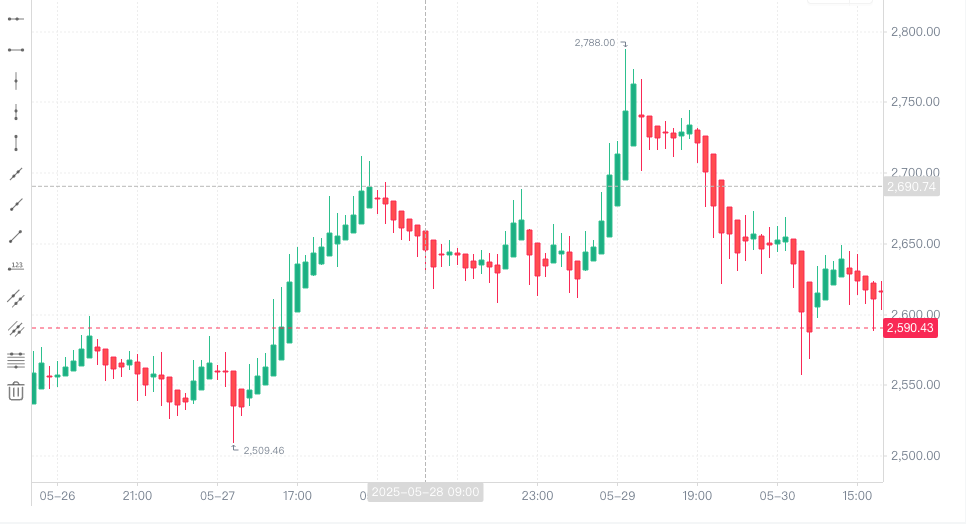Visual Enhancement Tool! Use Renko and Heikin Ashi to Understand Market Trends on FMZ
 0
0
 222
222

In quantitative trading, the traditional K-line chart is one of the most commonly used data presentation forms, but it also has certain limitations, such as insensitivity to fluctuations or excessive noise. In order to observe price trends more clearly, traders often use some improved charts, such as:
- Renko: based on price changes rather than time, it filtering market noise effectively.
- Heikin Ashi: by smoothing price data, it can show the trend direction more intuitively.
This article will introduce how to calculate the Renko and Heikin Ashi data based on ordinary K-lines on the FMZ Quant Trading Platform, and show the drawing effect, to help strategy developers analyze market trends more intuitively.
Renko
The Renko is based on “bricks”, and a new brick is drawn only when the price fluctuation exceeds a fixed range (such as $100).
- Advantages: Based on price changes, it filters out small fluctuations in the market and highlights the main trend.
- Applications: Suitable for identifying medium- and long-term trends and reducing noise interference in transactions.
Trading signal interpretation
- Trend confirmation: Continuous rising bricks indicate a strong trend and can be held; the appearance of reverse bricks is a trend reversal signal.
- Breakout trading: When a new brick appears, especially when it breaks the previous high/low, we can consider entering the market.
- False breakout filtering: Since the brick chart ignores small fluctuations, it helps to filter out small false breakouts during the oscillation period.
Core calculation logic:
- Set brickSize
- Based on the initial price, constantly compare whether the latest price deviates from the previous brick price by more than brickSize
- If the increase exceeds, draw an upward brick; the same applies to the decrease
Calculate the Renko, plot and implementation code:
/*backtest
start: 2025-05-01 00:00:00
end: 2025-06-06 00:00:00
period: 1h
basePeriod: 1m
exchanges: [{"eid":"Binance","currency":"ETH_USDT","balance":1000,"stocks":0.5}]
*/
let globalbricks = []
let lastBarTime = 0
function getBricks(r, brickSize, sourceAttribute, lastPrice) {
for (let i = 1; i < r.length; i++) {
let bar = r[i]
let price = bar[sourceAttribute]
let time = bar.Time
if (time < lastBarTime) {
continue
}
// Traversing the original K-line data
while (Math.abs(price - lastPrice) >= brickSize) {
if (globalbricks.length > 0 && time == globalbricks[globalbricks.length - 1].Time) {
time = globalbricks[globalbricks.length - 1].Time + 1000
}
// Construction bricks
let brick = {
Time: time,
Open: lastPrice,
Close: 0,
High: 0,
Low: 0
}
if (price > lastPrice) {
// Rising bricks
lastPrice += brickSize
brick.Close = lastPrice
brick.High = lastPrice
brick.Low = brick.Open
} else {
// Falling bricks
lastPrice -= brickSize
brick.Close = lastPrice
brick.High = brick.Open
brick.Low = lastPrice
}
// Put into array
globalbricks.push(brick)
// time is accumulated by 1 second to prevent a BAR from being disconnected when it is divided into multiple bricks
time += 1000
}
lastBarTime = bar.Time
}
return globalbricks
}
function getRenko(r, brickSize, sourceAttribute) {
// If the original K-line data does not meet the calculation requirements, it will be returned directly.
if (!r || r.length <= 0) {
return null
}
if (globalbricks.length == 0) {
return getBricks(r, brickSize, sourceAttribute, r[0][sourceAttribute])
} else {
return getBricks(r, brickSize, sourceAttribute, globalbricks[globalbricks.length - 1].Close)
}
}
function main() {
let c = KLineChart({
overlay: true
})
while (true) {
let r = _C(exchange.GetRecords)
let bricks = getRenko(r, 100, "Close")
bricks.forEach(function (brick, index) {
c.begin(brick)
c.close()
})
Sleep(1000)
}
}
Backtesting

Heikin Ashi
Heikin Ashi is a smoothing of traditional K-line
- Advantages: By smoothing price data, it provides a clearer trend direction and reduces false signals.
- Applications: Suitable for trend tracking strategies, helping traders hold positions longer in trends.
The calculation method is as follows:
HA_Close = (Open + High + Low + Close) / 4
HA_Open = (Previous HA_Open + Previous HA_Close) / 2
HA_High = max(High, HA_Open, HA_Close)
HA_Low = min(Low, HA_Open, HA_Close)
Heikin Ashi is essentially a moving average filtered K-line with stronger trend persistence.
Trend judgment and signal recognition
- A positive line with a large body and almost no upper and lower shadows indicates a strong upward trend
- A negative line with a large body and almost no upper and lower shadows indicates a strong downward trend
- The upper and lower shadows become longer, and the body shrinks. The trend weakens, so beware of reversals
- The body is very short, and the shadows are long. The market is volatile, so do not operate for the time being
Implementation code and plot:
/*backtest
start: 2025-05-01 00:00:00
end: 2025-06-06 00:00:00
period: 1h
basePeriod: 1h
exchanges: [{"eid":"Binance","currency":"ETH_USDT","balance":1000,"stocks":0.5}]
*/
function toHeikinAshi(records) {
if (!records || records.length == 0) {
return null
}
let haRecords = []
for (let i = 0; i < records.length; i++) {
let r = records[i]
let ha = {}
ha.Time = r.Time
ha.Close = (r.Open + r.High + r.Low + r.Close) / 4
if (i === 0) {
// The opening price of the first Heikin Ashi is the average of the opening and closing prices of the ordinary K-line.
ha.Open = (r.Open + r.Close) / 2
} else {
// The opening price of each subsequent candlestick = the average of the previous Heikin Ashi opening and closing prices
ha.Open = (haRecords[i - 1].Open + haRecords[i - 1].Close) / 2
}
ha.High = Math.max(r.High, ha.Open, ha.Close)
ha.Low = Math.min(r.Low, ha.Open, ha.Close)
haRecords.push(ha)
}
return haRecords
}
function main() {
let c = KLineChart({
overlay: true
})
while (true) {
let r = _C(exchange.GetRecords)
let heikinAshiRecords = toHeikinAshi(r)
heikinAshiRecords.forEach(function (bar, index) {
c.begin(bar)
c.close()
})
Sleep(1000)
}
}
Backtesting

END
The Renko and Heikin Ashi are powerful tools for trend traders:
- The Renko focuses on price displacement and is suitable for breakthroughs and trend confirmation.
- Heikin Ashi focuses on price smoothing and is suitable for trend position control.
- The two complement each other to improve the stability and anti-shock ability of trend strategy signals.
It is recommended to combine backtesting and live trading verification, choose a chart solution suitable for your own trading products and periods, and create a personalized quantitative trading system.
- The Hottest AI Trading Technology of 2025: A Smart Trading Guide to FMZ Platform with Claude (Part 2)
- When Top Comments Meet AI Quant: A Journey Into Strategy Implementation
- 当网友神评论遇上AI量化:一个交易策略的实现之旅
- The Hottest AI Trading Technology of 2025: A Smart Trading Guide to FMZ Platform with Claude (Part 1)
- 2025年最火AI交易技术:FMZ平台Claude智能交易指南(2)
- 2025年最火AI交易技术:FMZ平台Claude智能交易指南(1)
- Exploration of Counter-Trend Short-Term Mean Reversion Strategy: A Learning Practice of "Volatility Statistical Arbitrage"
- 逆势短线均值回归策略探索:一次"波差统计套利"的学习实践
- A Brief Discussion on the Development Record of A Cryptocurrency Trend Indicator
- 浅谈一个加密货币趋势指标的开发记录
- 视觉增强利器!在FMZ上用砖图与平均K线读懂市场趋势
- Building A Multi-Account Walkthrough System That Supports MyLanguage and Pine Strategy Language Based on FMZ
- 基于FMZ构建一个支持My语言和Pine策略语言的多账户跟单系统
- Design of Real Ticker Driven Simulation Trading System Based on FMZ Quant Trading Platform
- 基于FMZ量化平台的真实行情驱动仿真交易系统设计
- Using AI to Learn Strategy Design Reversely: A New Way to Improve Quantitative Trading Skills
- 用AI反向学习策略设计:提升量化交易技能的新思路
- The Go-Anywhere Quantitative Journey Starts from FMZ
- 说走就走的量化旅程,从 FMZ 开始
- Quantitative Practice of DEX Exchanges (4) - Strategy Access Test of WOOFi / EdgeX